
Easy Tonkotsu Ramen Recipe
Make my Easy Tonkotsu Ramen recipe for a delicious bowl of noodle soup just like your favorite ramen shop. I'll show you my pressure-cooker shortcut to make a rich, creamy, and intensely flavorful pork broth from scratch in just 3 hours!
Ingredients
For the Tonkotsu Broth
- 3½ lb pork leg bones (roughly 6 pieces; or use 4.5 lb (2 kg) pork backbones)
- 1.3 lb pork hock with skin (or use 1 pig foot/trotter)
- 2 QT water
- 1 head garlic (3 oz, 85 g)
- 1 knob ginger (1 inch, 2.5 cm; skin on)
For the Cold Brew Dashi (Japanese Soup Stock)
- 2 cups water
- 1 piece kombu (dried kelp) (6 x 6 inches, 15 x 15 cm per piece)
- 2 dried shiitake mushrooms (0.6 oz, 16 g)
- 5 iriko/niboshi (boiled and dried anchovies) (0.3 oz, 8 g; head and intestine removed)
For the Shoyu Tare (Seasoning Sauce)
- 2 Tbsp sake
- 2 Tbsp mirin
- 4 Tbsp usukuchi (light-colored) soy sauce
- 2 Tbsp water
- 1 piece kombu (dried kelp) (2.5 x 2.5 inches, 6 x 6 cm per piece)
- 25 g Diamond Crystal kosher salt (about 3 Tbsp, to taste; please weigh your salt; add more salt rather than tare so the soup won't get darker)
For the Hidden Seasonings
- 1 onion (medium)
- 2 green onions/scallions
- 1 cup katsuobushi (dried bonito flakes)
- 2 Tbsp sake
- 2 Tbsp rice vinegar (unseasoned)
For the Ramen
- 4 servings fresh ramen noodles (use fresh noodles, dry ramen noodles, or GF ramen noodles; I used frozen ramen this time)
- 2 green onions/scallions (chopped)
- 4 Ramen Eggs (Ajitsuke Tamago) (optional; cut in half; prepare them in advance using my Ramen Eggs recipe)
- 8 slices Homemade Chashu (Japanese Braised Pork Belly) (optional, or make Chicken Chashu)
- menma (seasoned bamboo shoots) (optional; store bought or make my Quick Menma Recipe)
- dried wood ear mushrooms (optional; rehydrated and thinly sliced)
- 1 Tbsp pickled red ginger (beni shoga or kizami beni shoga) (optional)
Instructions
To Pressure Cook the Tonkotsu Broth
- Gather all the tonkotsu broth ingredients.
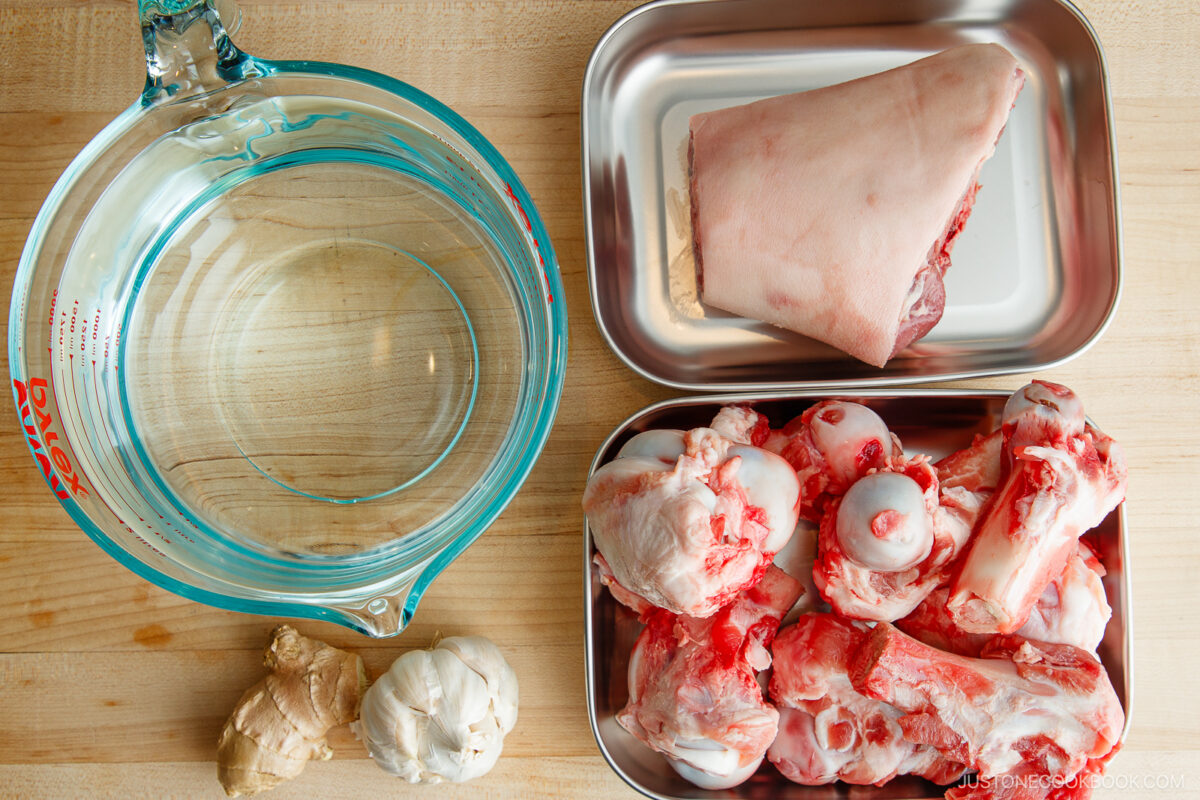
- Rinse 3½ lb pork leg bones and 1.3 lb pork hock with skin under running water.
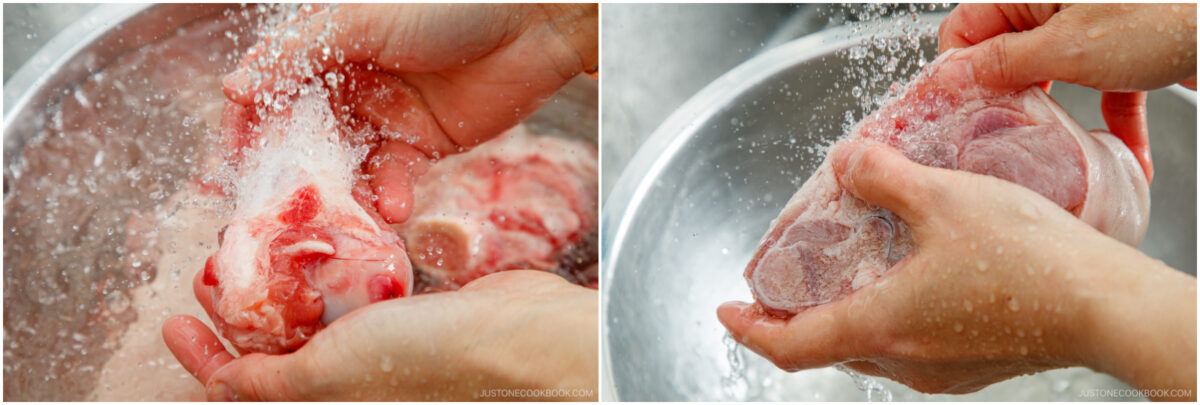
- Soak the pork bones and hock in a large bowl of water for 15 minutes to remove blood, changing the water several times. Nami's Tip: If you’re using pork backbones, remove the white spinal cord-like tissue, as it can give off a strong odor. Use chopsticks instead of your hands to avoid getting cut by the bones.

- Meanwhile, peel off the papery outer layers of 1 head garlic (keeping the head whole). Trim off and discard the root end. Then, slice the entire head in half crosswise to expose the cloves.
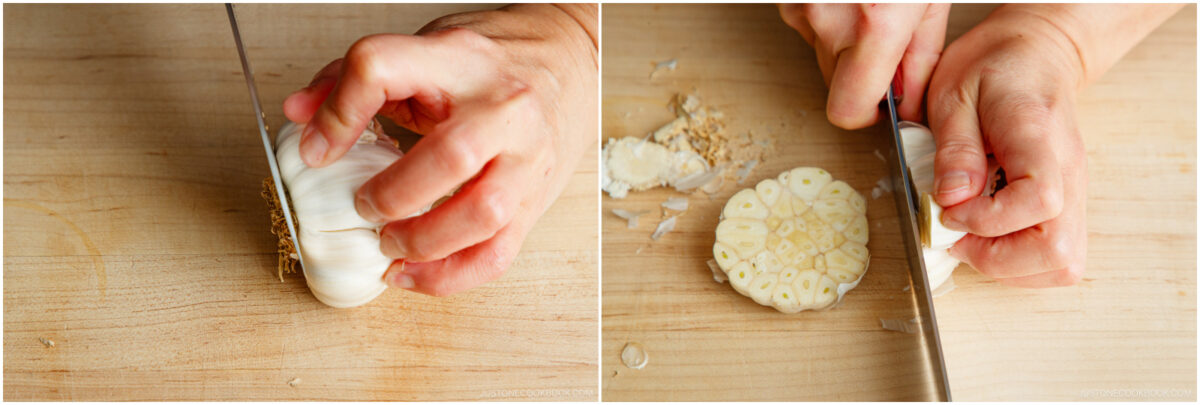
- Slice 1 knob ginger (skin on) into thin slices.
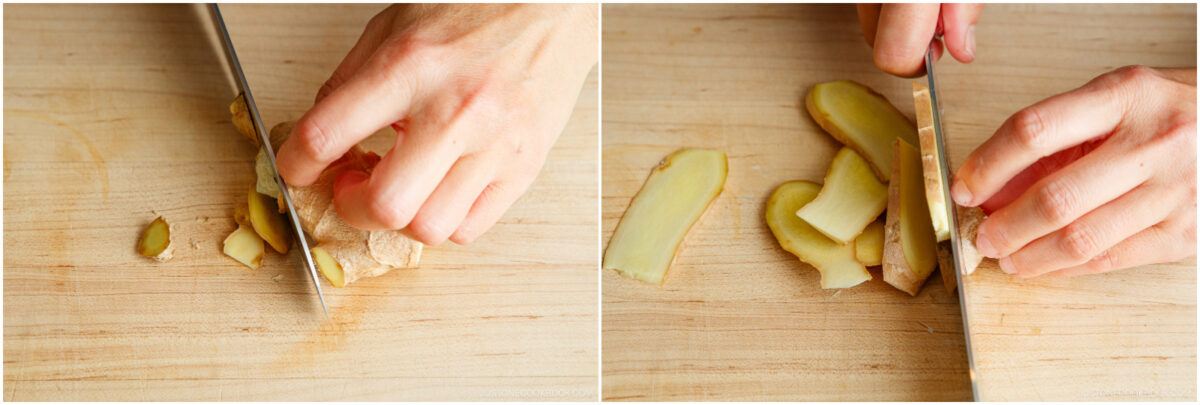
- Place the bones, hock, ginger, garlic, and 2 QT water in a pressure cooker pot or in the inner pot of an Instant Pot.
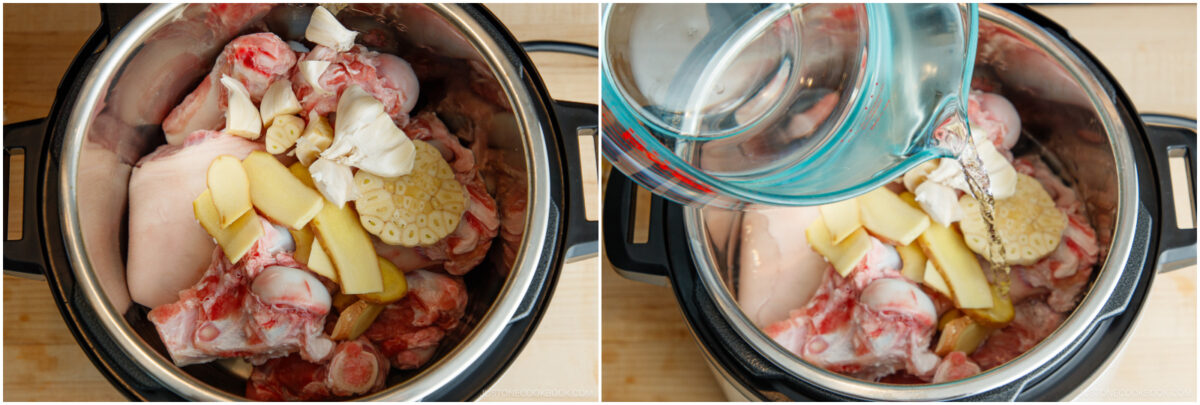
- Keep the water level at or below the maximum line (see image). If yours is above the line, remove some water and keep it aside for now, then add it back when boiling the broth later. Now, cover and lock the lid. Point the steam release handle at Sealing and not Venting. Select the Pressure Cooking mode. Set the cooking time to 60 minutes and select High pressure. Then, press Start. It‘ll take about 40 minutes to reach full pressure.You have 100 minutes. So, let's prepare the rest of the ingredients.

- No Pressure Cooker? Use a large stock pot. Add 2 cups (500 ml) more water and simmer the ingredients uncovered for 3–4 hours. You can also partially cover it to reduce evaporation. The longer you simmer it, the more flavor you'll extract from the bones.
To Cold Brew the Dashi
- Gather all the dashi (Japanese soup stock) ingredients.

- Add 1 piece kombu (dried kelp), 2 dried shiitake mushrooms, and 5 iriko/niboshi (boiled and dried anchovies) to 2 cups water to a medium bowl (I used a glass measuring cup). Set it aside at room temperature to extract the umami.
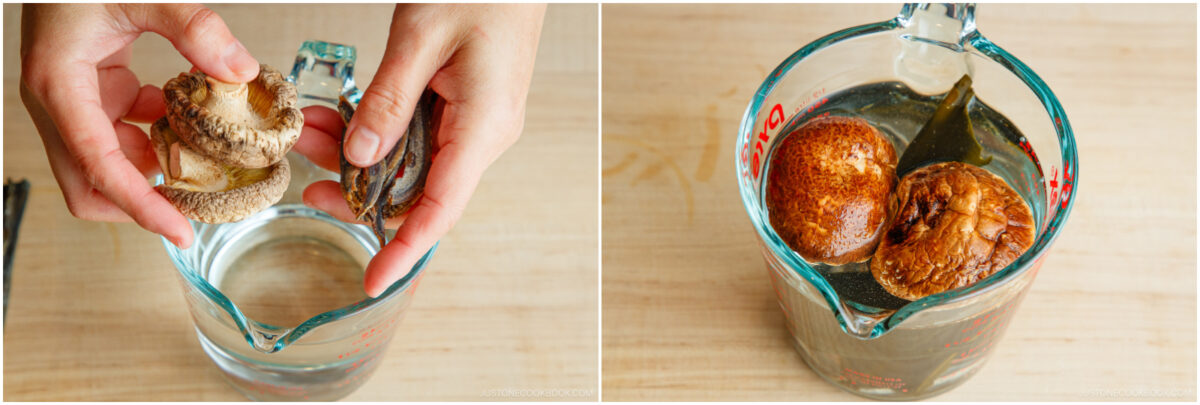
To Make the Shoyu Tare (Seasoning Sauce)
- Gather all the tare ingredients.
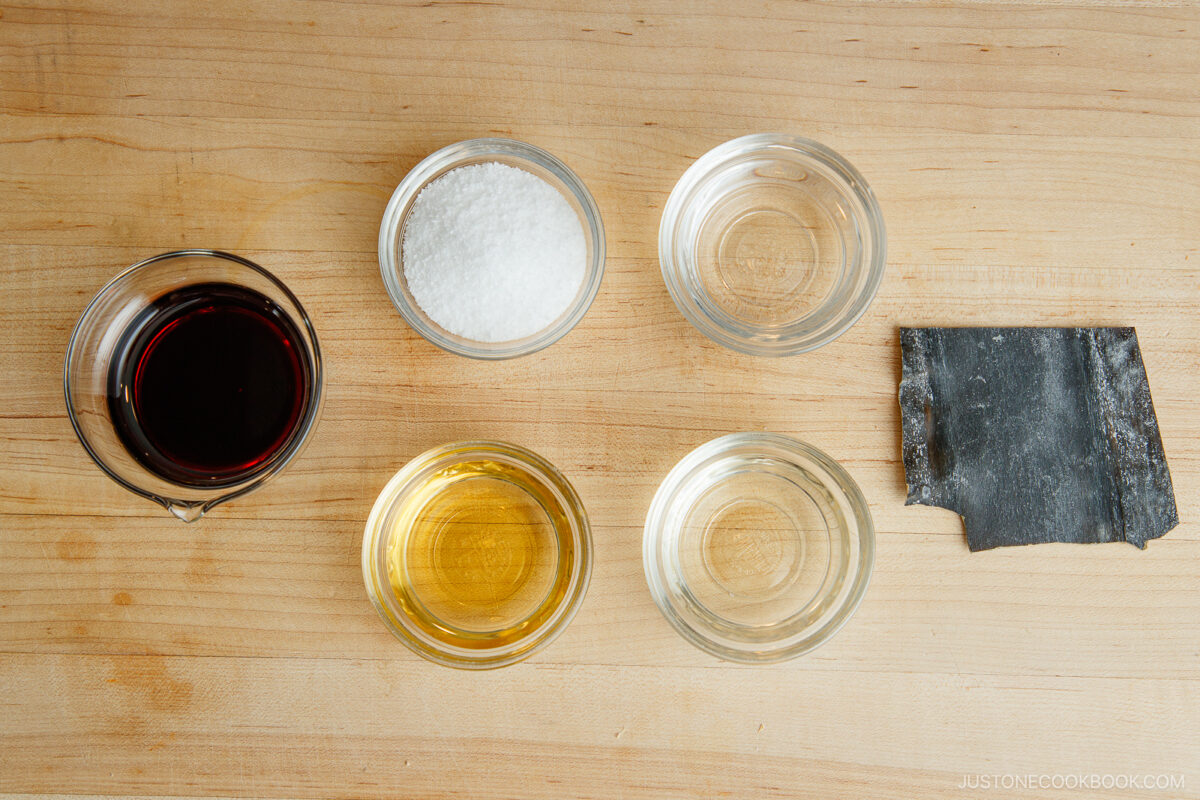
- Add 2 Tbsp sake, 2 Tbsp mirin, 4 Tbsp usukuchi (light-colored) soy sauce, and 2 Tbsp water to a small pot.
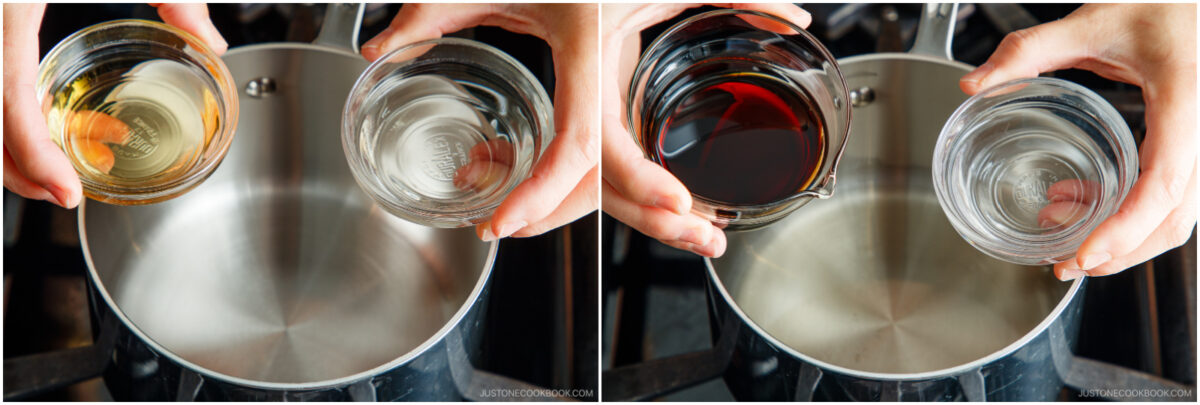
- Add 1 piece kombu (dried kelp) and heat over medium heat until nearly boiling. Reduce to low heat and simmer for 3–4 minutes, then turn off the heat.
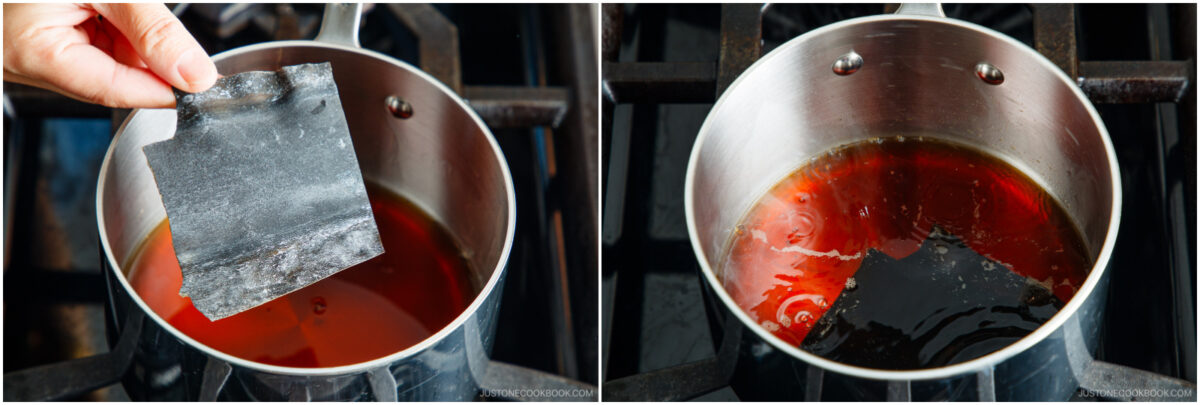
- Add 25 g Diamond Crystal kosher salt to the pot and stir well. Once the salt has dissolved, let the tare cool to room temperature. Nami's Tip: If you boil or reheat the tare after adding the salt, the salt may crystallize and not dissolve properly, so be careful.
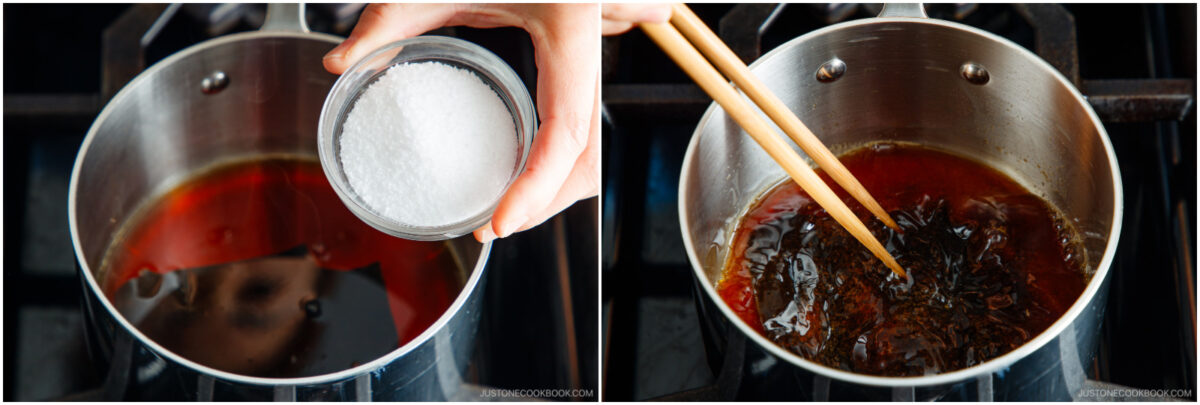
To Prepare the Hidden Seasonings
- Gather the ingredients for the hidden seasonings. Nami's Tip: Their subtle flavors help to deepen the taste of the tonkotsu broth.
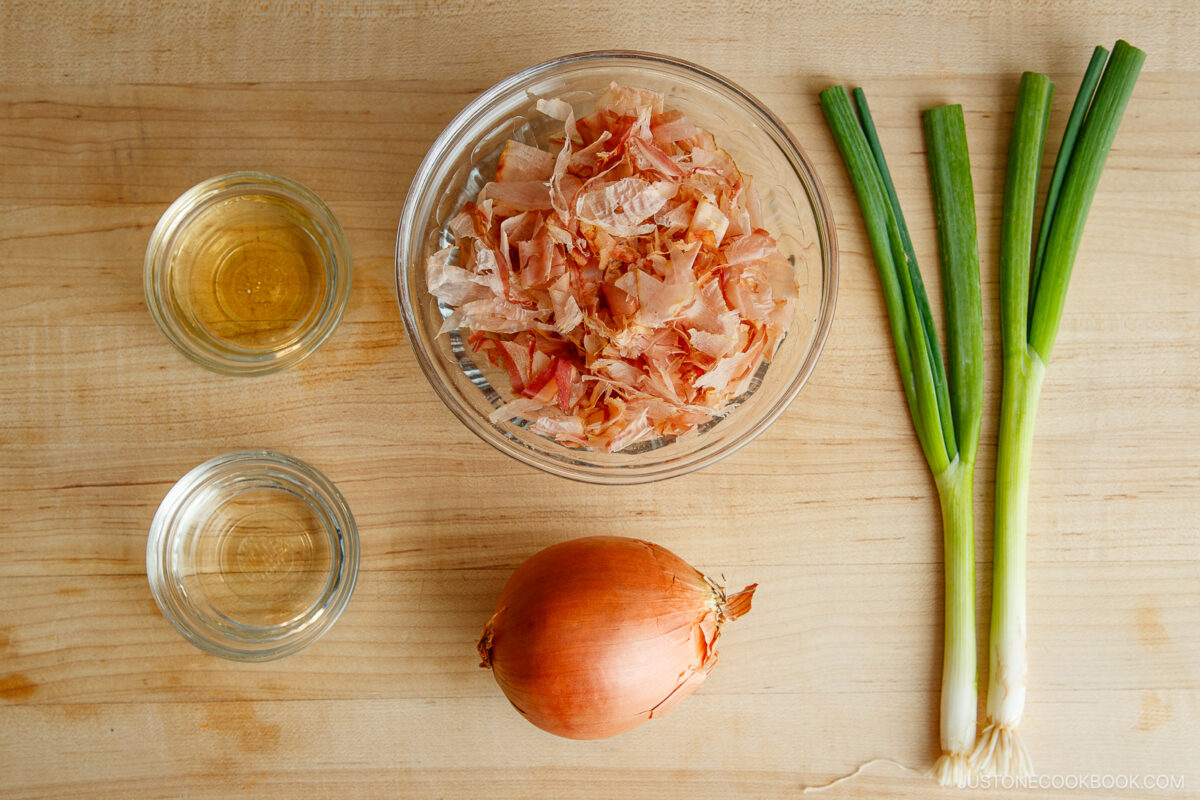
- Cut 1 onion in half with the skin on and 2 green onions/scallions in half crosswise. Set aside until the broth is done pressure cooking.
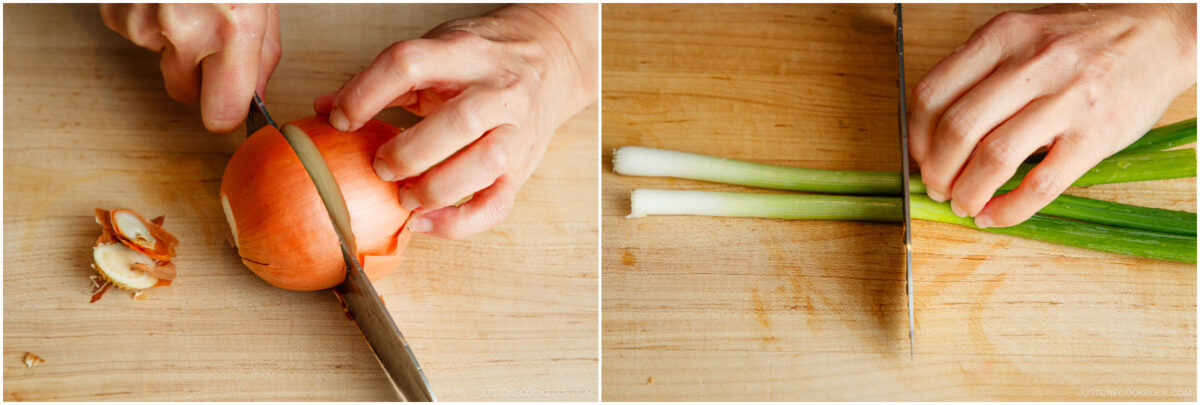
To Skim the Broth
- Immediately after the pressure cooking cycle ends, quick release the pressure by carefully turning the steam release valve with a long spatula to the Venting position (or by pressing the quick release button, depending on your model). Nami's Tip: Use a long spatula to turn the valve to avoid burning your hand with the hot steam, and lightly cover the valve with a paper towel to reduce splatter.
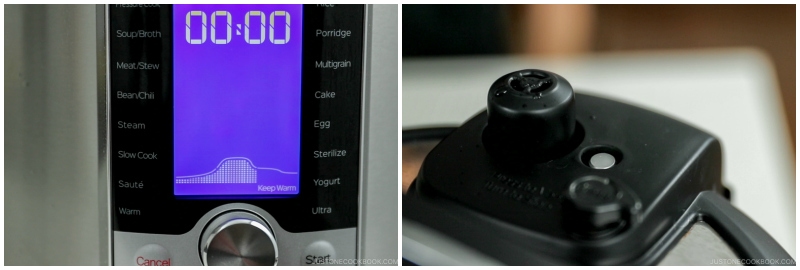
- Carefully open the lid. For the Instant Pot, select the Sauté mode (30 minutes) and high temperature. For a regular pressure cooker or stock pot, set the pot on the stove over high heat. Nami's Tip: Because the soup may splash during this step, you can transfer it to a larger pot if needed.Skim off the scum that floats to the surface of the broth with a fine-mesh skimmer. You'll continue to do this over the next hour. Nami's Tip: Be careful not to remove too much fat or bone marrow along with it, as the rendered fat is essential to a flavorful tonkotsu broth.
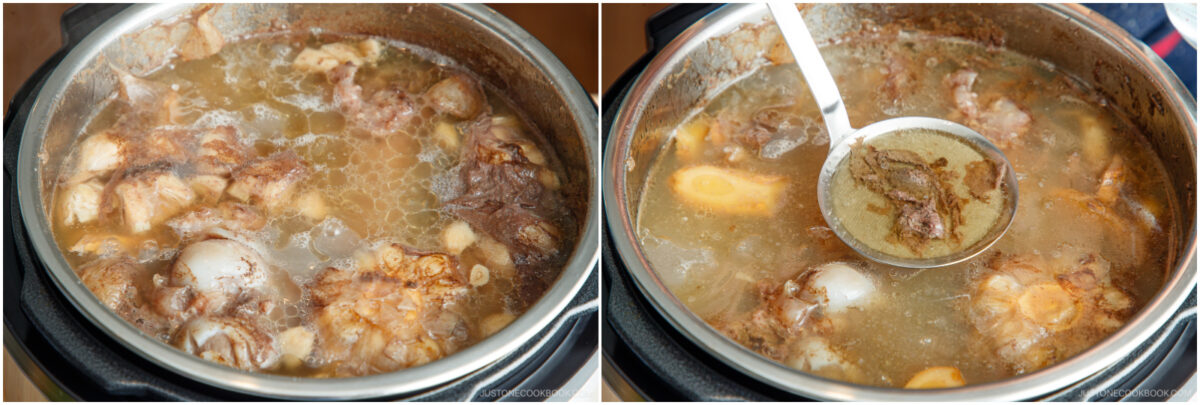
To Add the Hidden Seasonings
- Add the onion and green onions/scallions to the tonkotsu broth.

- Add 2 Tbsp rice vinegar (unseasoned) and 2 Tbsp sake. Now, carefully remove the shiitake mushrooms and anchovies that are soaking in the cold brew dashi and add them to the soup broth. Reserve the dashi liquid (we'll add it later).
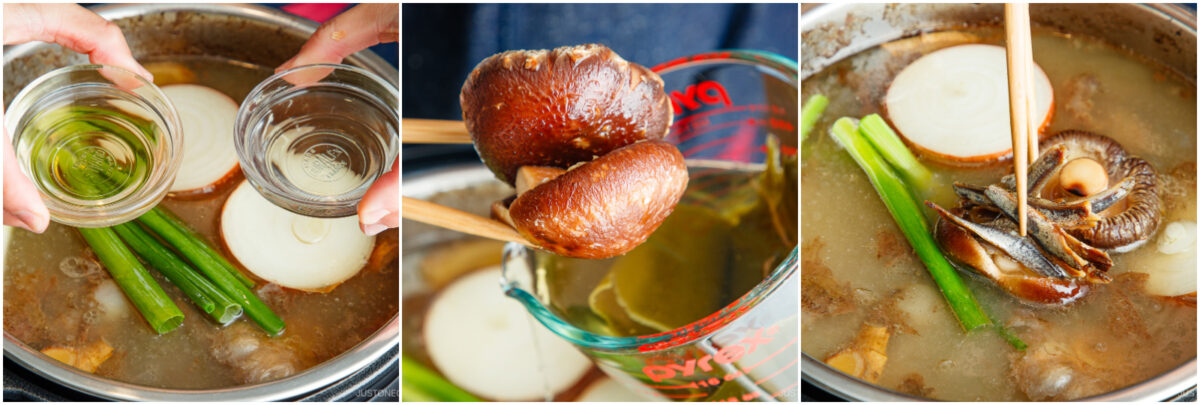
- Add 1 cup katsuobushi (dried bonito flakes) to the soup and stir well to combine.
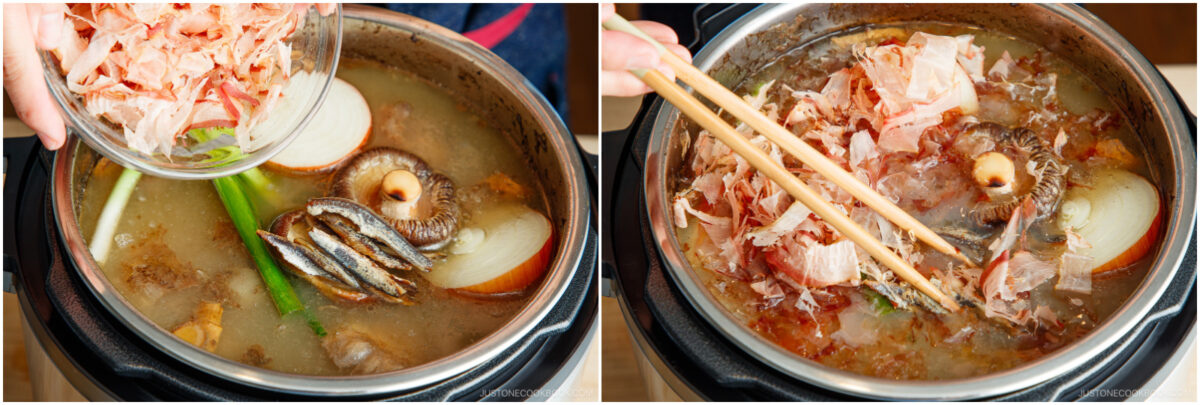
To Finish Cooking the Tonkotsu Broth
- Keep the soup broth at a rolling boil on Sauté mode (high). Skim the broth occasionally.

- Keep the heat high to ensure the proper extraction of flavor. Because the soup splashes easily, stir it regularly to calm the bubbling or place a mesh splatter guard on top. (With the Instant Pot, be mindful that the soup may splash into the gap between the outer and inner pots.) Once the soup slightly reduces after 30 minutes of boiling, pour only the dashi liquid into the pot; do not add the kombu.
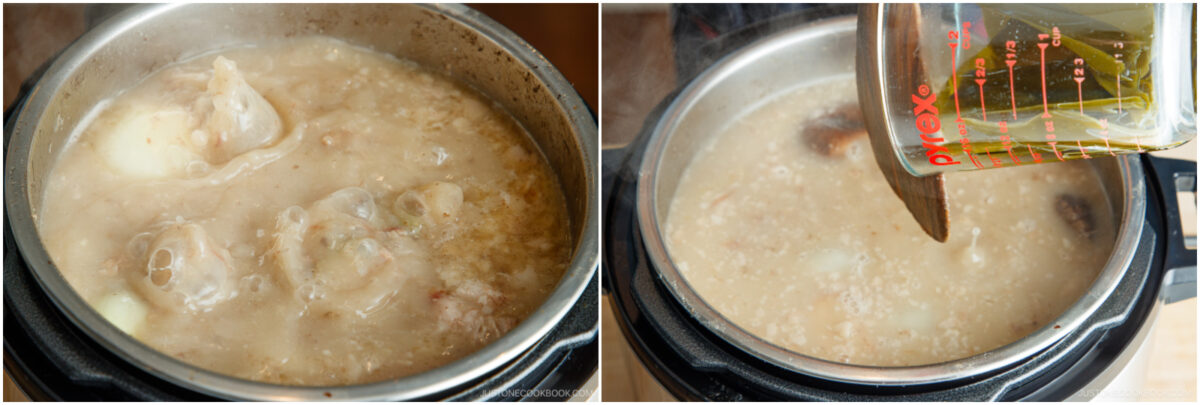
- Then, reset the Instant Pot to cook on Sauté mode (high) for another 30 minutes, stirring occasionally to help emulsify the soup.
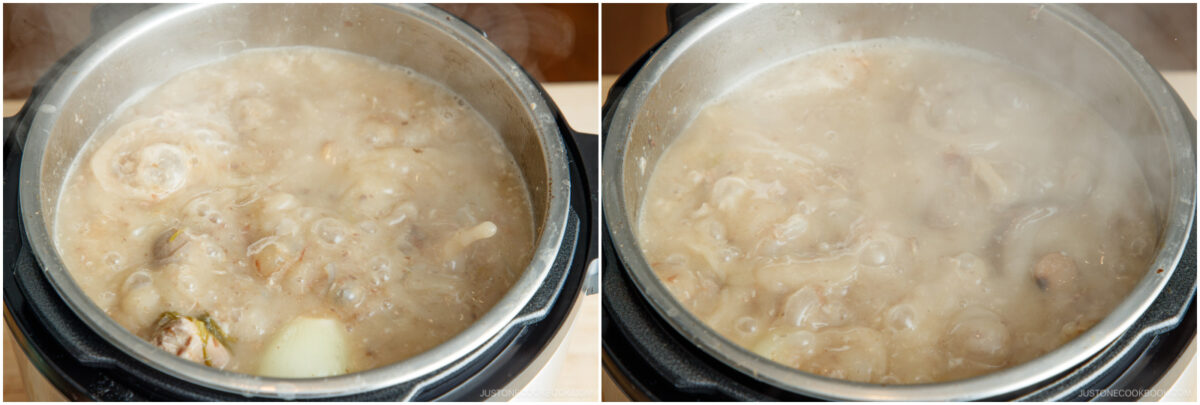
To Strain the Broth (Final Step)
- After a total of 1 hour of boiling the broth, turn off the Sauté mode (or turn off the heat on the stove). Pick up the big bones using tongs and transfer to a mesh strainer set over a clean medium pot. Let the soup broth drain into the pot, then discard the bones.
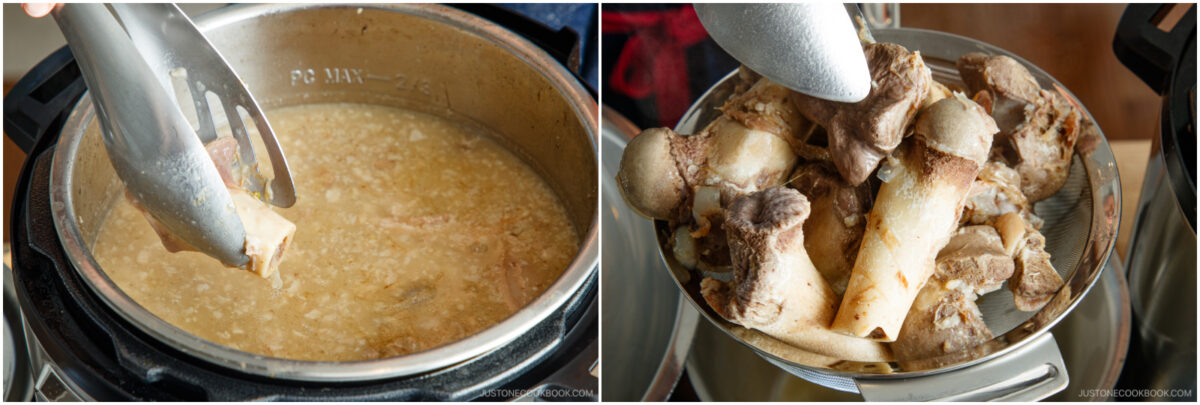
- Next, remove the other solids from the soup using tongs and transfer them to the strainer over the pot. Strain and press them well with a wooden spatula to squeeze out the liquid. Discard the solids.
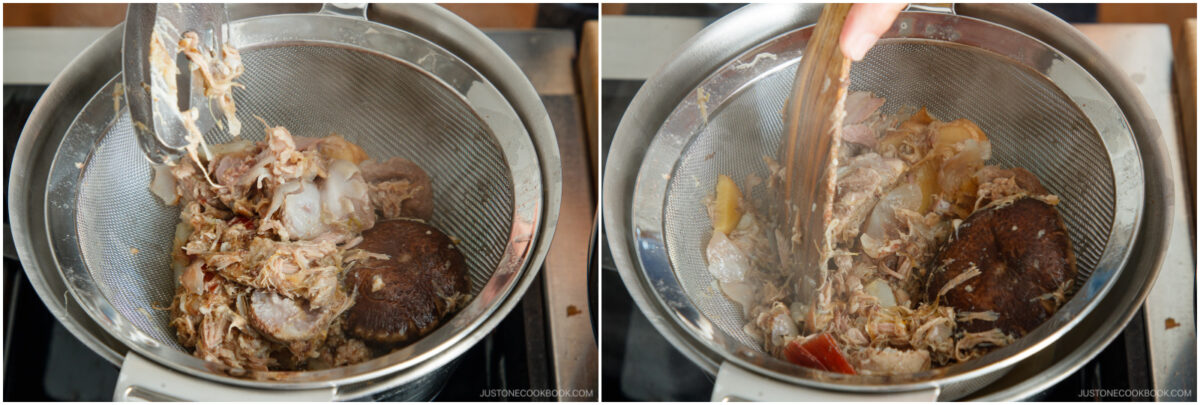
- Next, start straining the soup broth from the pressure cooker. First, pour a small amount of soup into the strainer and let it drain into the medium pot. Press the solids with the wooden spatula. Nami's Tip: It's harder to pour a lot of liquid at once and strain it, so work with a little bit of soup at a time.
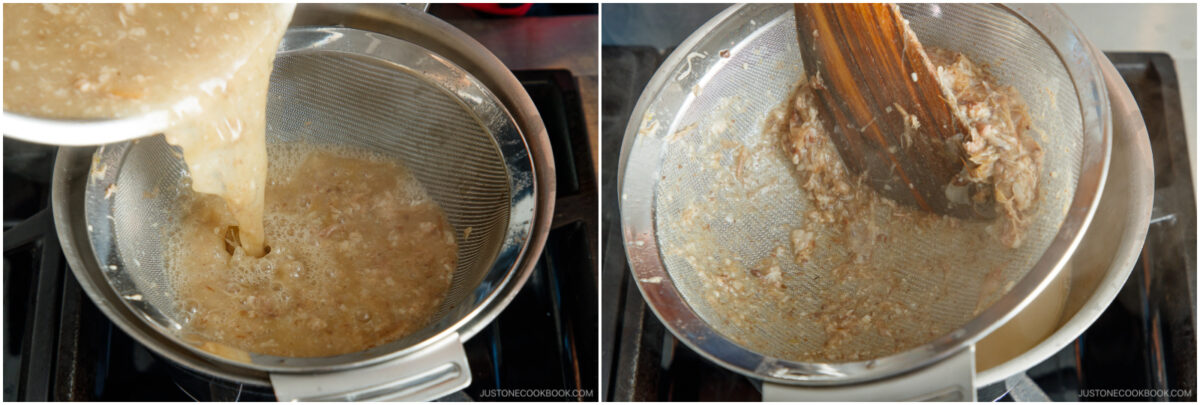
- Continue straining the soup, little by little. Remove the strainer when you're done. Now, your tonkotsu broth is ready to use. Heat it up if you're ready to eat ramen or store it for another day.
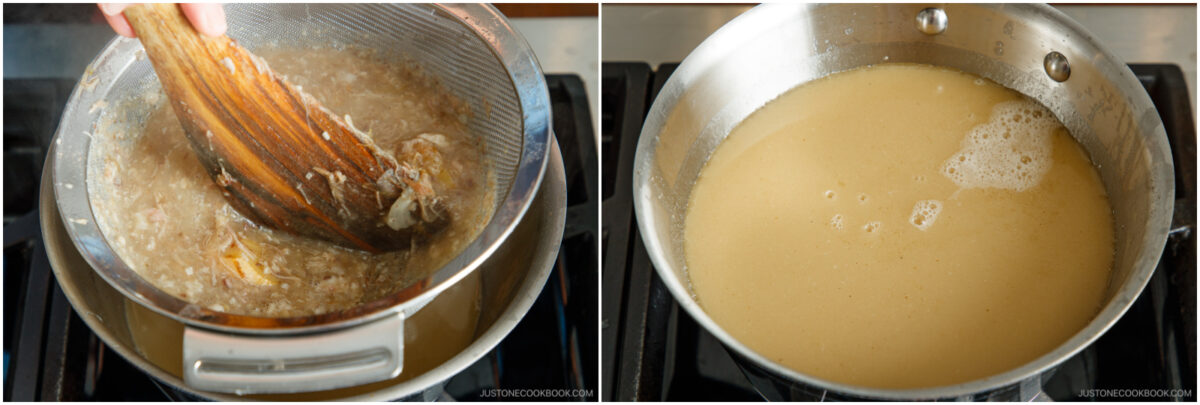
- To Store the Tonkotsu Broth for Later: If you’re not using the soup broth on the same day, cool it quickly to room temperature by setting the pot in an ice bath or cold water. Transfer the cooled broth to an airtight container and store it in the fridge for up to 3 days or in the freezer for 1 month. Be extra careful during summertime, as the soup can spoil quickly.
To Prepare the Tonkotsu Ramen
- Start boiling a large pot of water to cook the ramen noodles. Heat the tonkotsu broth and keep it covered so it's ready to serve as soon as the noodles are done cooking. Gather the tare, noodles, and toppings.
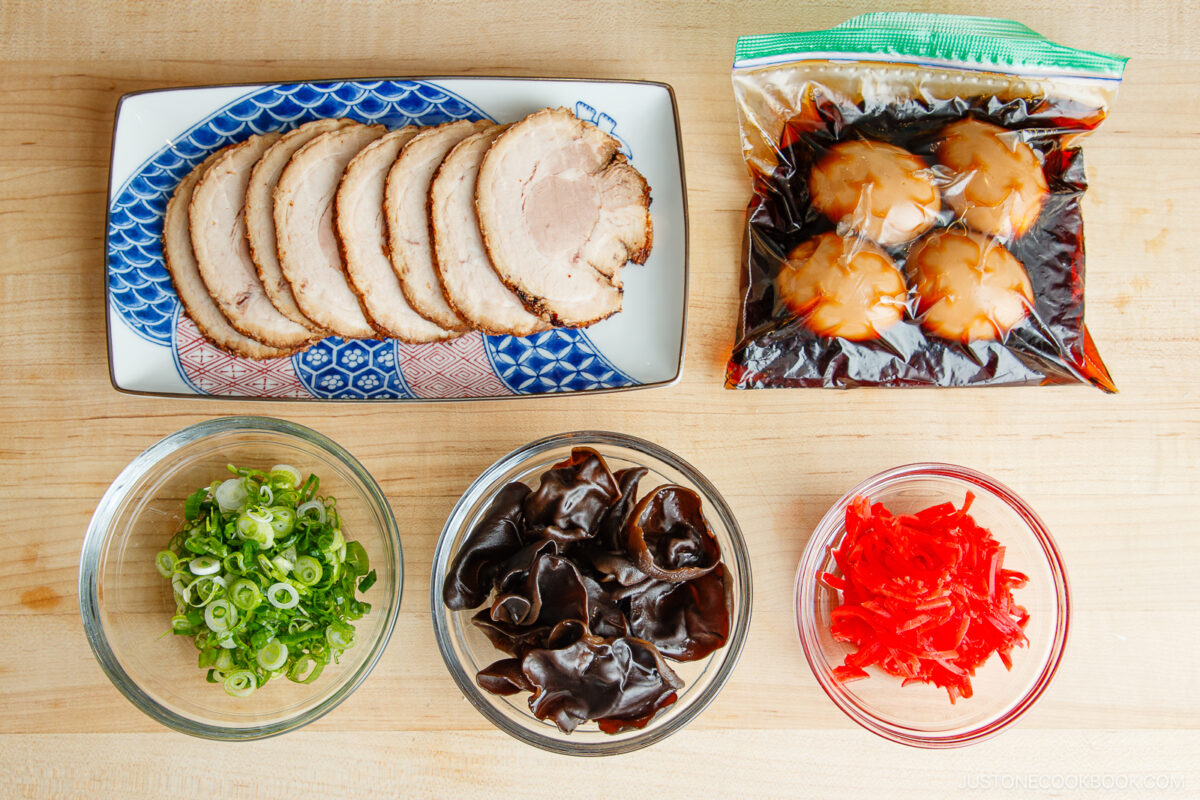
- Prepare your ramen bowls (I used the Ash Glazed Ramen Bowl from JOC Goods.) Warm up the bowls by filling them with hot water. Right before you cook the noodles, dump out the hot water and add 1 Tbsp tare to each warmed bowl. Nami's Tip: 1 Tbsp is the ideal amount of seasoning sauce—adding more will make the soup too dark.
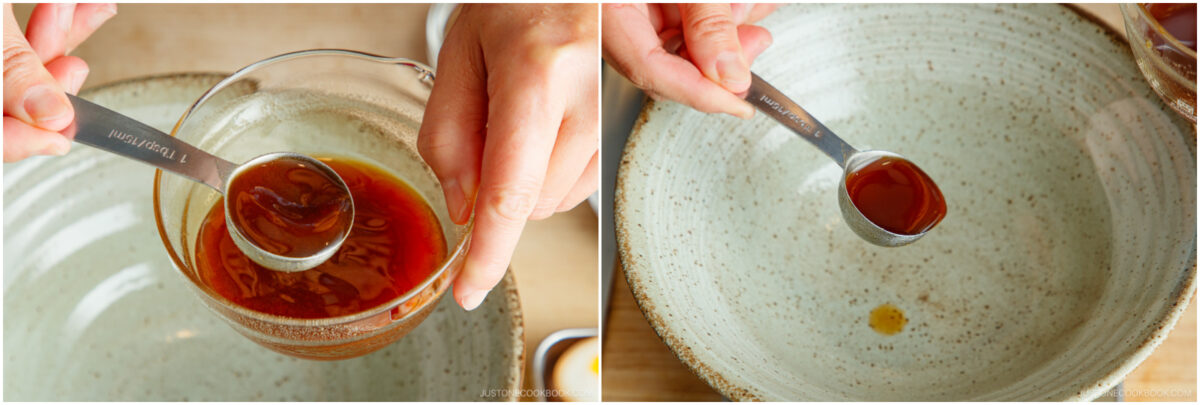
- Once the water is boiling, cook 4 servings fresh ramen noodles according to the package instructions to your desired firmness.
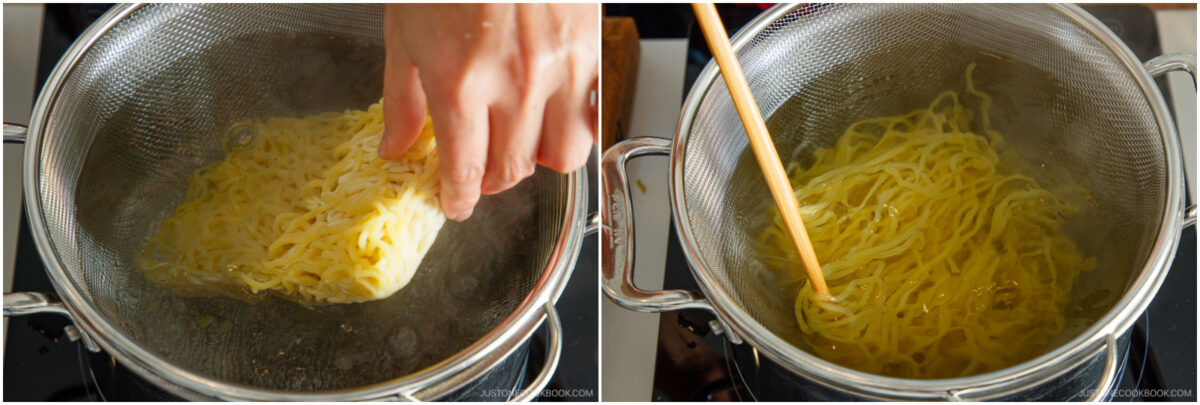
- Just before the noodles are done, add 350 ml (about 1½ cups) of tonkotsu broth to each ramen bowl. I used my kitchen scale, which is much easier than using a measuring cup that possibly cools down the broth.
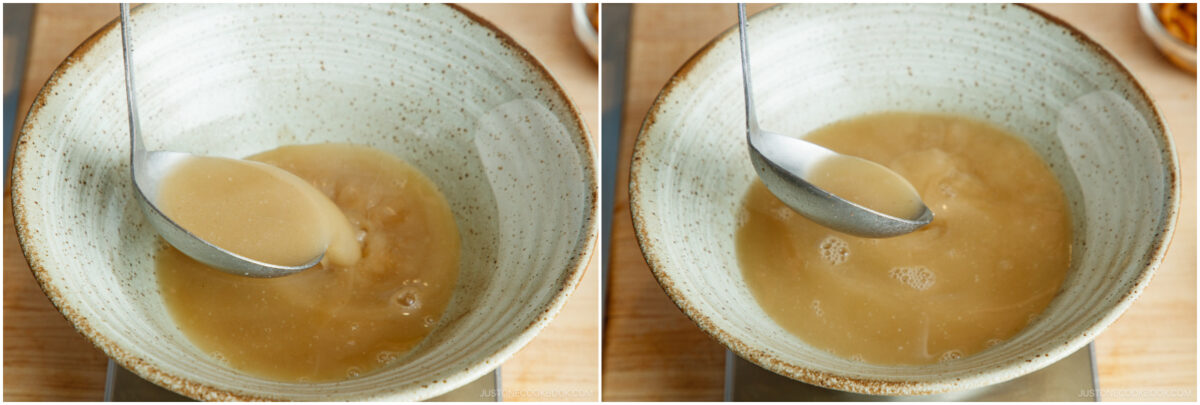
- Drain the noodles thoroughly and divide them into the bowls. Pull up the noodles from the soup with cooking chopsticks (I used Pastel Essence Cooking Chopsticks from JOC Goods), then lay them down into the soup so the noodles line up neatly in one direction.
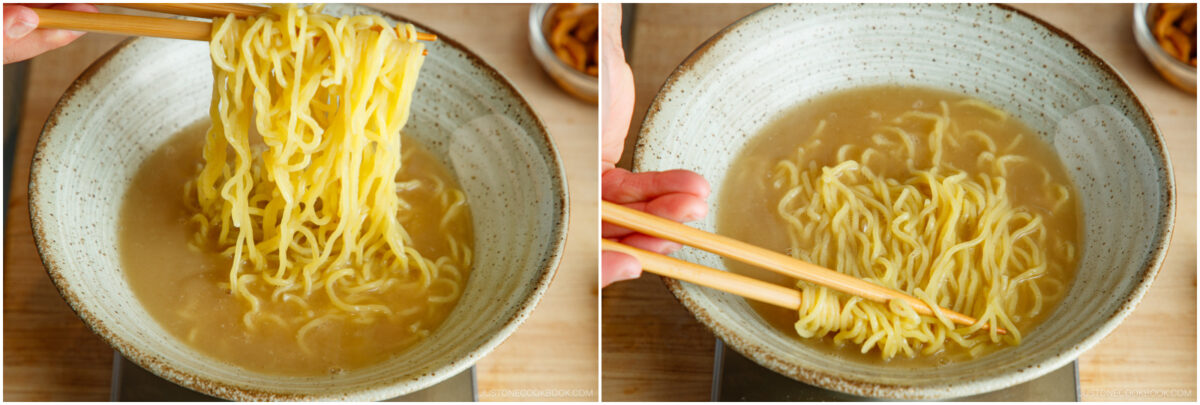
To Serve
- Quickly add your toppings and serve immediately—the noodles will soak up the soup if left too long. I added 2 green onions/scallions that I thinly sliced, 4 Ramen Eggs (Ajitsuke Tamago) cut in half, 8 slices Homemade Chashu (Japanese Braised Pork Belly), menma (seasoned bamboo shoots), dried wood ear mushrooms that I rehydrated and thinly sliced, and 1 Tbsp pickled red ginger (beni shoga or kizami beni shoga).

To Store
- You can store the leftovers in separate containers in the refrigerator or freezer for up to 3 days—just keep in mind that the flavor may start to fade after that. Boil the noodles right before serving.
Nutrition
Calories: 523kcal, Carbohydrates: 38g, Protein: 50g, Fat: 16g, Saturated Fat: 7g, Polyunsaturated Fat: 2g, Monounsaturated Fat: 6g, Trans Fat: 1g, Cholesterol: 259mg, Sodium: 1653mg, Potassium: 603mg, Fiber: 2g, Sugar: 6g, Vitamin A: 396IU, Vitamin C: 7mg, Calcium: 204mg, Iron: 4mg